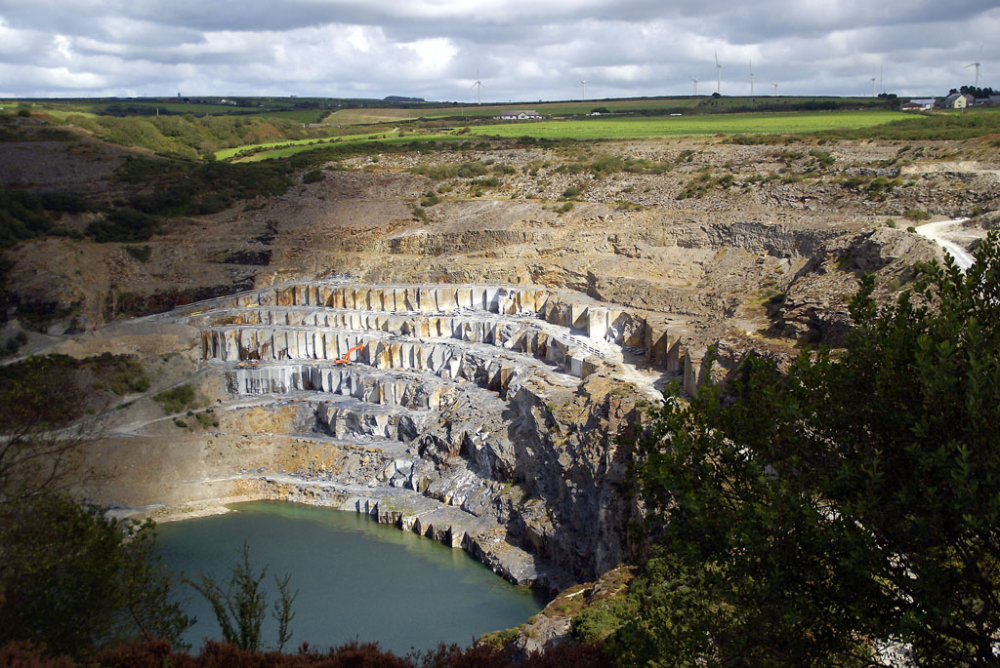Delabole Slate
Delabole is a town in Cornwall UK, it is named after and famous for having the oldest and largest slate quarry in the country, used for over 600 years and with, and said to privide a continued good supply of slate. Delabole slate is the traditional blue-grey slate that comes from this quarry, it is well known for its durability, weather resistance, as well as aesthetic appearance (far left below).
Delabole slates tend to be more robust than standard slates, often laid with what is called a triple lap gauge (or triple lap), this means they have a deeper overlap than a normal standard double lap roof, so overlapping three layers of slate rather than two, which improves durability. Traditionally Delabole slate roofs are referred to as scantile roofs, with the triple overlap and a bedding of wet lime mortar, laid between the slates, and pointed at the edges. Such roofs are very durable as they are commonly found in the fishing villages along the coast of Cornwall and Devon where roofs need to with stand strong winds and sea water.
Deliou Manor, near the current quarry is recorded in the Doomsday Book, in the 1200s the quarry site became known as Delyou Bol in old Cornish, where delyou means flakes or leaves and bol means a pit, it translates as pit of flaky stone. in the 1700s many companies dug from the site, which were amalgamated under the management of Robert Bake of Tynes in the 1800s and The Old Delabole Slate Company was founded and became a Limited Liability Company in 1898. The quarrying of roofing slate and by-products has continued since. Delabole slates were used on Winchester Cathedral, and also the favourite roof covering of the small fishing village of Clovelly in North Devon and many vernacular buildings across Devon and Cornwall.
[edit] Related articles on Designing Buildings
- Battens.
- Ceiling tiles.
- Ceramic tiles.
- Clovelly, a village changing hands and changing with the times.
- Conservation.
- Domestic roofs.
- Flashing.
- Flat roof defects.
- Heritage.
- Historic environment.
- IHBC articles.
- Institute of Historic Building Conservation.
- Nails - a brief history.
- Photocatalytic tiles.
- Pitched roof.
- Planning for sustainable historic places.
- Reconciling conservation and sustainable development.
- Roof coverings.
- Roof insulation.
- Roof slates.
- Roof tiles
- Roofing defects.
- Shingle roofing.
- Sustaining Clovelly, a history, its management and retrofit.
- Sustainability and Conservation of the Historic Built Environment - an IHBC Position Statement.
- Thatch roofing.
- Tiles.
- Tile roofing
- Types of nails.
- Types of roof
- Weatherboarding
- World Heritage and Sustainable Development: new directions in world heritage development..
[edit] External links
https://cornishstory.com/2023/09/11/delabole-slate-quarry/
http://www.stoneroof.org.uk/historic/Historic_Roofs/Grouted_roofs.html
Featured articles and news
RTPI leader to become new CIOB Chief Executive Officer
Dr Victoria Hills MRTPI, FICE to take over after Caroline Gumble’s departure.
Social and affordable housing, a long term plan for delivery
The “Delivering a Decade of Renewal for Social and Affordable Housing” strategy sets out future path.
A change to adoptive architecture
Effects of global weather warming on architectural detailing, material choice and human interaction.
The proposed publicly owned and backed subsidiary of Homes England, to facilitate new homes.
How big is the problem and what can we do to mitigate the effects?
Overheating guidance and tools for building designers
A number of cool guides to help with the heat.
The UK's Modern Industrial Strategy: A 10 year plan
Previous consultation criticism, current key elements and general support with some persisting reservations.
Building Safety Regulator reforms
New roles, new staff and a new fast track service pave the way for a single construction regulator.
Architectural Technologist CPDs and Communications
CIAT CPD… and how you can do it!
Cooling centres and cool spaces
Managing extreme heat in cities by directing the public to places for heat stress relief and water sources.
Winter gardens: A brief history and warm variations
Extending the season with glass in different forms and terms.
Restoring Great Yarmouth's Winter Gardens
Transforming one of the least sustainable constructions imaginable.
Construction Skills Mission Board launch sector drive
Newly formed government and industry collaboration set strategy for recruiting an additional 100,000 construction workers a year.
New Architects Code comes into effect in September 2025
ARB Architects Code of Conduct and Practice available with ongoing consultation regarding guidance.
Welsh Skills Body (Medr) launches ambitious plan
The new skills body brings together funding and regulation of tertiary education and research for the devolved nation.
Paul Gandy FCIOB announced as next CIOB President
Former Tilbury Douglas CEO takes helm.
UK Infrastructure: A 10 Year Strategy. In brief with reactions
With the National Infrastructure and Service Transformation Authority (NISTA).
























